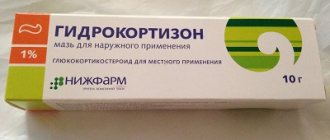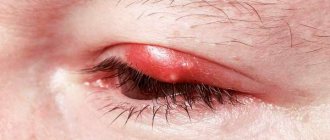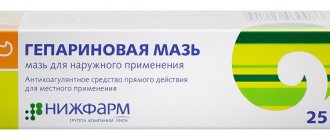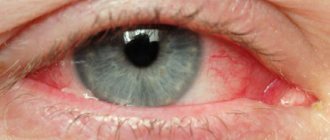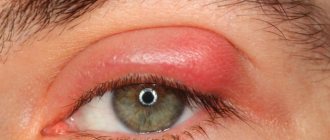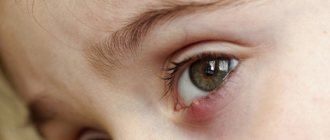Ointments for stye on the eye are first aid preparations for hordeolum. Proper use of products in ointment form will relieve discomfort and external defects, eliminate the cause of the inflammatory process, thanks to bacterial, anti-inflammatory and decongestant properties.
Proper use of ointment for stye on the eye relieves discomfort in a short time
Floxal Ointment - instructions for use
The active component of the ointment has a bactericidal effect on pathogens, i.e. penetrates their cells and destroys the DNA structure, causing them to die. The most active effect is observed against gram-negative microorganisms, incl. against chlamydia and mycoplasma. A slightly less noticeable result was observed in the fight against cocci and some other gram-positive bacteria. At the same time, the drug has no effect on anaerobic representatives of pathogenic microflora.
Is Floxal an antibiotic or not?
Yes, Floxal ointment is an antibiotic containing a substance from the fluoroquinolone group, which has a broad antimicrobial effect. However, the local form of antibiotic use is safer for the body, because the active substance is actively absorbed into the layers of the epidermis and practically does not penetrate into the general bloodstream, as a result of which general systemic reactions of the body are excluded.
Pharmacological group
The ointment is an antibacterial drug from the group of fluoroquinolones intended for local use in ophthalmology.
Composition of Floxal
The active substance of Floxal is ofloxacin, a broad-spectrum antibiotic, of which 1 gram of pharmacological product contains 3 milligrams. The composition is supplemented with paraffin, wool fat and white petroleum jelly.
Release form Floxal
The ointment is a mass of uniform consistency with a pale yellow tint. It is packaged in tubes weighing 3 grams, 1 piece per package.
Photo of the packaging of floxal - eye ointment 3 mg g (ofloskacin) for placing in the conjunctival sac
Floxal recipe in Latin
To purchase the ointment, you will need to obtain an appropriate prescription from the ophthalmologist, which the specialist will write after examining the patient and making a diagnosis. The form should look like this:
Rp: Ung. Floxal 0.3% - 3.0
DS: put behind the lower eyelid 3 times a day, course – 10 days.
Read further: All over-the-counter antibiotics, reasons for banning their free circulation
Indications - why Floxal ointment is prescribed
The ointment is usually the basis for the treatment of diseases affecting parts of the visual organs, the development of which is caused by the proliferation of bacteria. Floxal ointment is most often prescribed for conjunctivitis and blepharitis - inflammation of the outer shell of the eye and the edges of the eyelids, which most often occur simultaneously.
Floxal ointment is effective against barley on the eye - a pathological condition when bacterial growth is observed in the hair follicle of the eyelashes or the ducts of the sebaceous glands, resulting not only in redness of the tissues, but also in the discharge of purulent contents. At the same time, Floxal has a double effect in barley: it fights pathogenic bacteria and gradually reduces the degree of inflammation.
The list of prescriptions also includes pathological processes in the following parts of the organ of vision:
- meibomian glands, located in the cartilage tissue of the eyelids (meibomites) and often called “internal stye”;
- iris or ciliary body (iridocyclitis or anterior uveitis), usually affects patients suffering from rheumatism;
- corneas (keratitis), usually arising as a result of injuries to the eyeball or a complication after a viral disease;
- choroid (uveitis), located between the sclera and the retina and resembling a bunch of grapes;
- lacrimal sac (dacryocystitis), which is caused by narrowing or blockage of the lacrimal canal;
- sclera of the eye (scleritis), in which pronounced swelling and accumulation of foreign particles in the tissues are observed throughout its entire thickness.
The ointment is indispensable for ulcerative or erosive lesions, usually observed on the visible surface of the corneal layer. Floxal ointment is also prescribed for chalazion - one of the types of meibomitis, in which a tumor-like formation occurs due to blockage and swelling of the sebaceous duct, but in this case the drug usually acts as part of drug therapy.
The drug can be used for both acute diseases and their chronic forms. It can also be used as a preventive agent to prevent the addition of infectious microflora after eye surgery.
Read further: How to treat adult conjunctivitis at home: ointments, drops, rinses
Floxal contraindications
Because the drug practically does not penetrate into the bloodstream, there are few contraindications to its use. The list includes:
- hypersensitivity of the active ingredient or other antibiotics from the fluoroquinolone group, incl. previously registered, or any excipient;
- the period of bearing a child and breastfeeding.
Dosage and method of use of Floxal
Before using the ointment, you should carefully rinse your eyes and remove “purulent crusts” if they are present. Next, carefully, without touching the surface of the eye with the tip of the tube, place a strip of ointment about one and a half centimeters long behind the lower or upper eyelid, having first pulled it back slightly.
The procedure is carried out 2-3 times a day, if we are talking about chlamydia infection - the frequency of bookmarks increases to five. It is allowed to use Floxal in the form of drops at the same time; in this case, the eyes are first instilled, and then the ointment is applied.
The duration of treatment is determined by the doctor individually for each patient, but should not exceed 10-14 days.
Many parents ask at what age is Floxal used for children and can it be prescribed to newborns?
The safety of prescribing Floxal ointment and drops to patients in the first year of life has not been studied. According to strict indications, in the absence of an alternative, the ointment can be used (strictly as prescribed by a doctor).
There is no special pediatric dosage of the drug, so a standard form of the drug is prescribed, but children are given it no more than three times a day, and the length of the strip should not exceed 1 centimeter. At the end of the procedure, the ointment should be carefully distributed behind the eyelid with a light massage movement of the fingers.
Side effects and effects of Floxal
The ointment is not capable of causing systemic side effects, but some patients, especially those prone to allergies, may experience the following reactions:
- increased redness of the mucous membrane;
- acute burning sensation, especially in the first minutes after applying the product;
- discomfort and itching;
- sensation of a foreign body in the eyes;
- swelling of the eyelids;
- feeling of dryness in the eyes;
- a sharp increase in sensitivity to bright light;
- lacrimation.
Isolated cases of dizziness have also been recorded. All reactions, if they are not provoked by the patient’s hypersensitivity, go away on their own after a short period of time and do not require symptomatic therapy or drug withdrawal.
Undesirable effects from use also include effects on the central nervous system, which may result in some problems with concentration and reaction speed, and a temporary deterioration in visual acuity. This action prohibits prescribing Floxal to persons driving complex or highly dangerous mechanisms or motor vehicles.
Read further: When can you take antibiotics and antivirals at the same time?
Floxal during pregnancy and breastfeeding
There is no clinical data on how ofloxacin affects the developing fetus, therefore Floxal is prohibited for use during pregnancy. The lactation period is also a contraindication, because... the active component in small quantities can penetrate into mother's milk, and this increases the likelihood of allergic reactions in the newborn.
Compatibility of Floxal with alcohol
Due to minimal systemic absorption, the ointment does not react with alcohol. However, before drinking alcoholic beverages, using ointment for barley, conjunctivitis or other infectious pathology of the organs of vision, you should take into account the fact that ethyl alcohol has an extremely negative effect on the patient’s immune system, incl. and local. Even small doses of alcohol can further weaken the body’s natural defenses, and this will cause the activation of bacteria and the effect of treatment will be significantly weakened, and if you abuse strong drinks, it will be reduced to zero.
Interaction with other drugs
There are no clinical studies on the compatibility of Floxal with other groups of drugs, therefore, before including the ointment in the therapy, you should clarify what other medications the patient is taking and make a decision based on the characteristics of the drug interactions of these pharmacological products.
Shelf life, storage conditions
To store the ointment, you should choose a dark place, inaccessible to children, where the air temperature will not exceed 25 degrees. The shelf life of Floxal ointment when sealed is 3 years, and after opening it is only 6 weeks.
Which ointment for stye on the eye is more effective?
The danger of stye on the eye is often underestimated. Many people try to get rid of it exclusively using folk methods. And this is fundamentally wrong.
Barley is an inflammation of the hair follicle of the eyelash or the sebaceous gland located next to the eyelash bulb. Initially, swelling and slight edema appear on the eyelid.
After a few days (from 2 to 4), the yellowish head of the abscess ripens.
The greatest danger of the disease is that this abscess will burst and pus will fill the conjunctival sac. The causative agent of the disease is most often staphylococcus. And it is impossible to defeat him with tea leaves or urine. Incorrect treatment only makes the problem worse.
If such a pathology appears, you should immediately consult a doctor so that he can select the most effective ointment for barley on the eye.
The effectiveness of treating barley with ointments
This dosage form works best on the abscess. The ointment destroys harmful microflora, specifically combating the causative agent of the disease. The abscess matures over time, and the pus breaks out. The product prevents infection of other tissues.
It envelops the abscess, acting as a protective barrier against pus. If you do not use medicine and try to squeeze out the abscess, you can seriously harm yourself. Pure pus will spread over the eyeball and conjunctival sac.
Because of this, phlegmon of the eyelid, meningitis and abscess can develop.
Not all ointments can give a positive result during treatment. Therefore, it is important to consult a doctor in time and get tests done. A swab from the conjunctiva will help determine the causative bacteria.
Also, the cause of the appearance of stye on the lower eyelid can be problems with the endocrine system, digestive organs, and even the presence of worms and mites.
Based on the test results, the doctor will select exactly the ointment that will be most effective in each individual case.
Phloxal - analogues in ointments
The only direct analogue of the drug in ointment form is Ofloxacin.
Analogs of Floxal ointment in terms of therapeutic action include the following ointments:
- Albucid;
- Acyclovir;
- Demazol;
- Tetracycline;
- Erythromycin.
Read further: TOP 5 eye drops with a broad-spectrum antibiotic
Levomekol - features of use in the treatment of barley
Levomekol was created back in the 1970s. specialists from the Kharkov Pharmaceutical Institute.
Chemical composition of the ointment (per 1 g):
- Chloramphenicol (antibiotic) – 7.5 milligrams;
- Methyluracil (immunostimulant) – 40 milligrams.
Polyethylene oxide 400 and 1500 is used as a forming base.
Thus, the drug has a combined effect on the source of the disease:
- Chloramphenicol inhibits protein biosynthesis in Staphylococcus aureus cells;
- Methyluracil, participating in the exchange of nucleic acids, improves tissue regeneration, which, by increasing its volume, reduces the area of bacterial damage in the hair follicle or sebaceous gland.
Note that the presence of a purulent environment does not in any way worsen the therapeutic effect of Levomekol. The development of resistance in Staphylococcus aureus to the antibiotic effects of the drug occurs so slowly that it can not be taken into account at all.
Procedure for treating barley with Levomekol
The method of applying the ointment will depend on the location of the source of the disease.
If swelling and a yellowish point of release of pus have formed on the outer side of the eyelid, then you can simply apply a thin layer to the source of inflammation. In this case, the patient will not experience any discomfort.
If the inflammation occurs on the inside of the eyelid, then the application procedure will be slightly different: pull back the eyelid and carefully apply a thin layer of Levomekol to the affected area.
Below we attach a video where the doctor shows in detail how to properly apply the remedy to the inside of the eyelid:
Please note that some of the ointment will definitely end up on the eyeball, which will cause the patient’s vision to become slightly unfocused. Therefore, it is better to apply Levomekol before bedtime, then it will not cause any unpleasant sensations.
This drug demonstrates the greatest effectiveness in the early stages, since chloramphenicol will inhibit the development of the pathogenic colony of Staphylococcus aureus, which means that even a weakened immune system will be able to cope with them.
The use of Levomekol is contraindicated in acute or chronic leukemia, hemoblastosis, lymphogranulomatosis, as well as in case of hypersensitivity of the body to chloramphenicol or methyluracil.
It is not recommended to use the drug to treat children under 3 years of age.
Which is better, Floxal or Albucid?
Albucid is an antibiotic from the sulfonamide group, whose effectiveness and safety have been tested by time. However, the list of indications for the drug is limited - these are conjunctivitis, blepharitis and ulcerative lesions of the cornea, complicated by the separation of pus, as well as infections caused by chlamydia and gonococci.
Otherwise, there are no differences between the medications, except for the price of the drug - Albucid can be purchased at a pharmacy for an average of 20-30 rubles, while for Floxal you will have to pay about 160 rubles.
Side effects and contraindications
Like any medical product, Hydrocortisone has a number of contraindications. The drug is not prescribed in the following cases:
- in the presence of corneal injury;
- children under 12 years of age;
- in the presence of trachoma;
- during the vaccine period;
- in the presence of ocular tuberculosis;
- if you are allergic to a component of the drug.
During pregnancy and breastfeeding, the ointment can be used, but under the strict supervision of a specialist. If the dose is incorrectly selected or the drug is used for other purposes, the following adverse reactions may occur:
- burning;
- itching;
- swelling of the eyelid;
- fungal invasion;
- formation of secondary barley.
The ointment is also not recommended for use before driving, as it temporarily impairs visual acuity. If any side effects occur, therapy should be stopped and contact a specialist as soon as possible.
Which is better, Floxal or Tetracycline ointment?
Tetracycline ointment has a wider spectrum of action than Floxal, but it is more often used to combat skin infections; it is prescribed less often in ophthalmology. The main disadvantage of the tetracycline drug is the age restriction - it can only be used by patients over 8 years of age. The advantages include the price - rarely the cost exceeds 20 rubles.
The final choice is made by the attending physician, but if we are talking about treating an adult, it is better to give preference to Tetracycline ointment.
Reviews
Svetlana To resolve the stye, the ophthalmologist prescribed me tetracycline eye ointment (2 times a day) and hydrocortisone ointment at night - after all the pus has come out. After the first application of hydrocortisone, I felt a strong burning sensation. I read in the instructions that such a side effect is possible, but the pain was so unbearable that I had to stop using the ointment. I never decided to apply it again. She was treated with tetracycline.
Tatyana One morning discovered a small lump on her son’s upper eyelid. I went to the local clinic, the doctor diagnosed a chalazion, or stye. Prescribed Tobradex eye ointment at night and Tobrex drops 3 times during the day. Actually, a three-year-old child can only be given ointment at night - since he immediately rubs his eyes, the ointment was applied when he fell asleep. We were treated for 10 days.
Anastasia We used Tetracycline several times for barley. In my opinion, this is the best ointment for eye diseases. And also drops of Floxal.
About the drug
Eye ointment reduces inflammation and reduces the migration of leukocytes and lymphocytes. The drug reduces capillary permeability, fights hyperemia and reduces the severity of the early immunological response.
Glucocorticosteroids are used topically in ophthalmology. The components of the drug are excreted by the kidneys and intestines. It penetrates poorly through the outer shell of the eye into the aqueous humor and is slightly absorbed into the systemic bloodstream, which is why allergies may develop in the form of a rash on the body.
